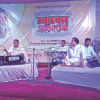Lalon Fakir was a great Bengali poet who created thousands of songs touching on the issues of humanity, spirituality, and society. Most of these songs speak against the rigidities of religion and social norms, arguing for a life harmonious beyond caste and creed. Through his deeply intriguing yet accessible lyrics, Lalon invites us inward on a journey into self-discovery and enlightenment.
Moner Manush
Amar moner manusher shone
Milon hobe koto din e
Chatok pray ahornishi
Cheye ache kaloshoshi
Hobo bole choron-dashi
O ta hoina kopalguune
To meet my beloved
How long do I have to wait?
Day in day out like a swallow
I stare at the black moon
To become a devotee
But luck does not let it happen.
Faraway into the thick fog, the musician clad in a dull mustard suit, vanishes into thin air. His followers with long beards, unkempt hair and hands swinging in the air, playing to the tunes of the ektara follow him religiously —into the oblivion.
Nobody dares to question their motive, religion or background. For these mythical beings, the followers of Lalon, swear they have none. All they seek in this world are the guidance of the Murshid– Guru, reconnection with their missing soul, and sight of the One and Only– the Alif, the Kali, the Supernatural, the Creator.
Many have attributed a particular faith to the Lalon, sometimes calling him a Sadhu, and at other times, a Fakir. But nobody actually knows the beginning of his story. But it is certainly clear from his songs that being illiterate didn't stop Lalon from achieving the knowledge of the supernatural.
Jyotirindranath Tagore, the elder brother of the famous novelist Rabindranath Tagore, was the last person who sketched an outline of the mythical Lalon Fakir, and from this very simple sketch does the world get to paint a picture of the enigma that once roamed the earth till his soul left his body on October 17, 1890 in Cheuria, Kushtia – aged almost 117 years.
To Lalon, Jyotirindranath asked for an answer; he wished for a simple explanation to what the spiritual guide meant, when he addressed the term MonerManush recurrently in many of his songs. As the pages of history would have it, the answer was neither direct nor easy to comprehend. Most followers of his existence believe that MonerManush is a reflection of 'the self.' It has also been signified by the term Arshinagar – House of Mirrors, a term popularised by Lalon himself; where people can only see their own true reflection, the saint in them, the devil and the one that rises above both, to become united with the universe.
Khachar Bhetor Ochin Pakhi
Khachar bhetor ochin pakhi kemne ashe jaay
Tarey dhorte parle mono beri ditam pakhir paay
Aat kuthuri noy doroja aata
Moddhe moddhe jholka kaata
Taarupore shodor kotha
Ayna-mahalTaay
How does an unknown bird
Come and go into the cage?
If I could catch it
I would put my mind's shackles around its feet.
Eight rooms and nine doors
Are in the cage
Dazzling light flashes through at times
On top is the main-room, the mirror chamber
Harinath Majumder, better known as Kangal Harinath, a Bengali journalist and a good friend plus disciple to the legendary Lalon Fakir, asked the Guru-Shai why he preferred to stay in hiding, deep in the forests. This is the exact moment,it is fabled, that the famous song – Khachar Bhetor Ochin Pakhi, was composed. The guru laughed at his disciple's query and explained to him 'in his own way' that the world was a creation of the Supreme; and that he didn't require permission to roam around, preferring to stay in the forest because of its calm and quiet.
But the real cage was existent elsewhere – referring to his body as the cage and his soul as the bird that left the cage often on its free will.
"I wish I could put shackles on its feet and enclose it within the cage," sang Lalon.
Lalon Ki Jaat
Shobloke koy Lalon ki jaat shongshaare
Lalon bole, jatir ki rup dekhlamna dui nojore
Jodi Sunnot dile hoy musolman
Nari loker ki hoy bidhan
Bamon chini poita proman
Bamoni chini kishe re
"What is the caste of Lalon?" asks everyone
"I haven't seen its shape and form in my eyes," says Lalon
Muslim is he who is circumcised
What happens to women then?
Brahmin is recognised when he wears the sacred thread
But how to recognise a Brahmin woman then?
One question that Lalon had been asked repeatedly over his lifetime from both the orthodox Muslims and Hindus had been the identity of his faith, to which he replied skilfully all the while that his belief could not be attributed to any one religion.
To him, the divisions of the sects were all man-made and what truly mattered was the devotion of the Supreme by the 'people' of all religions, colours, and races.
He believed in gender equality and hence, the lyrics of 'Lalonkijaatshongshaare' were composed and etched by his disciples. He clearly explains in this particular song that the 'straight-forward identifications' that people often cry-out, simply to segregate themselves from each other, don't even include the female gender.
He concludes the same poem reminding his followers that the identification of caste and religion fails to exist during the'time of birth' and at the 'death bed.' And that the religious doctrines were sold at the 'bazaar of saints' to benefit a different cause.
There's another song — JaatGelo Bole, by the mythical poet that indulges in a similar thought process.
Jaat Gelo Bole
Jaat gelo, jaat gelo bole eki ajob karkhana
Shotto pothe keo noy raji shob dekhi tana-nana
Jokhon tumi bhobeele
Tokhon tumi ki jaat chile
Ki jaat hoba jabar kaal e
Shei kotha keno bolo na
Caste is lost; caste has gone missing
What a queer cry all around!
None is ready to traverse the virtuous path
All I see is dithering over 'yes or no.'
When you came into this world
What caste were you then?
What caste will you be while departing?
Why don't you say that?
The poet, the mystique, the legend, the spiritual leader, and the philosopher, whatever you want to call the man — you may. He appears differently to every person and each of us find different meanings to his songs.
What may seem life-altering and purely spiritual to me may seem to be something much simpler to another! The meanings differ, the viewpoints differ and even the transliteration may differ. And maybe because of this very fact, the minstrel's words remain 'vague' as of today, it still seems enchanting to the rest of the world, from his disciples to regular people like us.
But we must all agree to at least one of his genres, the 'Parapartotto,'the genre that speaks about the journey from this world to the next. People of religions must accept one true fact recognised by the famous bard of Bengal,that 'every being that lived, must die' and maybe that's why the following is a personal favourite of mine.
Paar e Loiya Jao
Paar e loiya jao amay
(Ami) opar hoye boshe achi
Ohey doyamoy
Take me to the shore
O my Lord
I could not set out
I kept seated
Special thanks to M H Haider for helping with the research
Songs composed by Fakir Lalon Shah
Translations by Haroonuzzaman, from his book Selected Songs of Lalon
The reiteration of Lalon's ideologies is based on the author's personal views









Comments